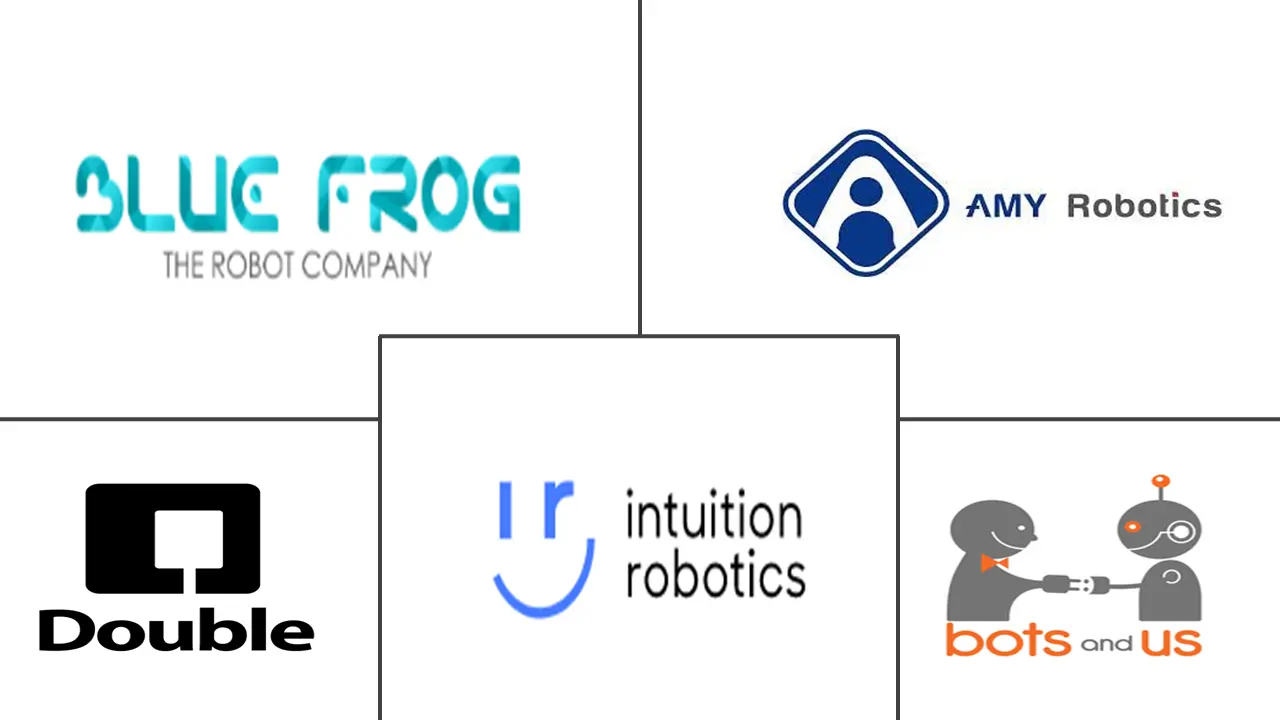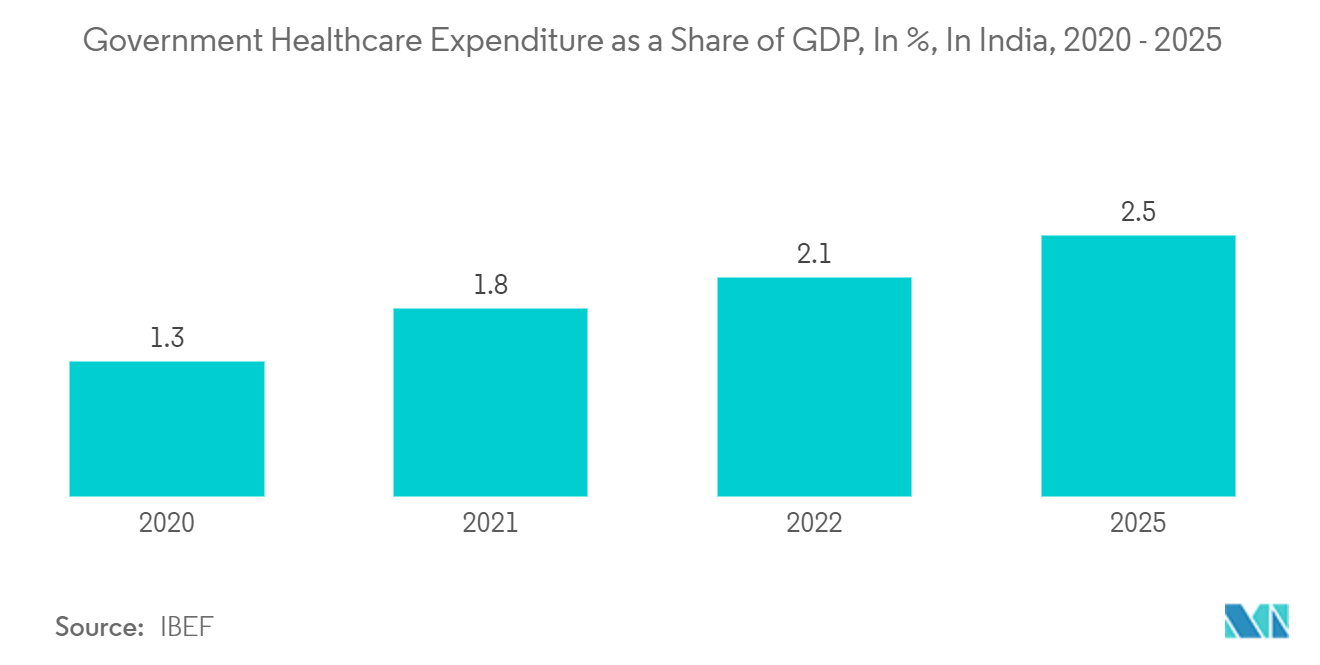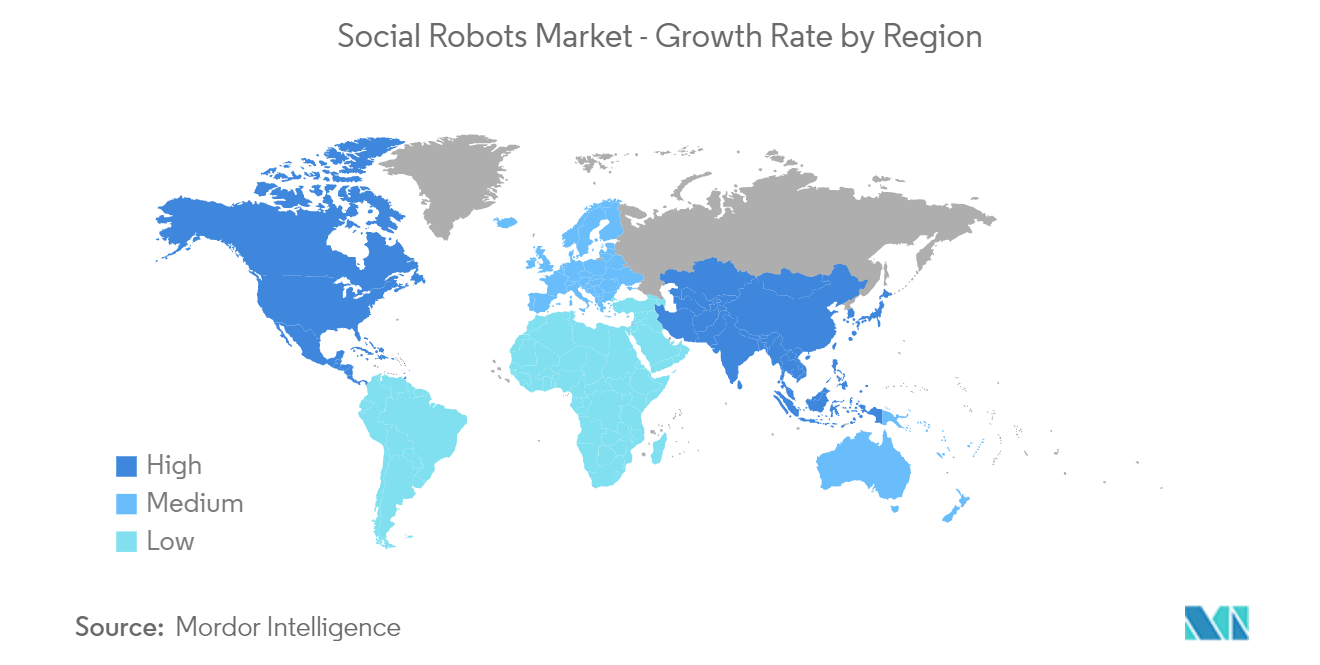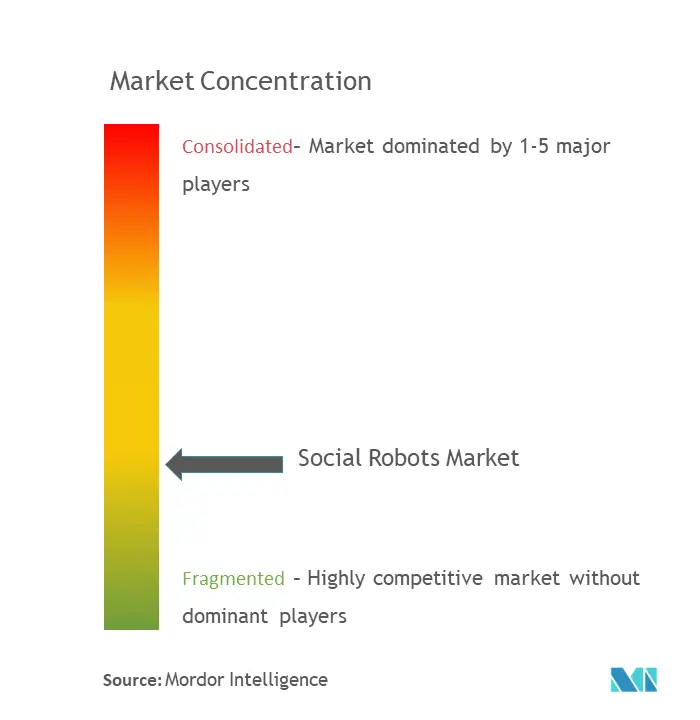Social Robots Market Size

| Study Period | 2019 - 2029 |
| Market Size (2024) | USD 5.64 Billion |
| Market Size (2029) | USD 22.93 Billion |
| CAGR (2024 - 2029) | 32.40 % |
| Fastest Growing Market | North America |
| Largest Market | Asia-Pacific |
Major Players
*Disclaimer: Major Players sorted in no particular order |
Social Robots Market Analysis
The Social Robots Market size is estimated at USD 5.64 billion in 2024, and is expected to reach USD 22.93 billion by 2029, growing at a CAGR of 32.40% during the forecast period (2024-2029).
As the world is increasingly moving toward advanced technology adoption across a range of sectors and applications, robotics and automation play a crucial role in safeguarding people while enabling them to co-exist with robots.
- Social robots work closely with humans; hence, they respond to the users and adapt to changing behaviors. Over several years, the massive improvements in sensors, actuators, and abilities have allowed humans to naturally interact with robots through facial expressions, eye contact, and conversation. As a result of the massive improvements, there has been a rise in interest in deploying social robots in medical industries. For instance, the behaviors of social robots, including imitation, and eye gaze, have impacted autism therapy positively compared to children with autism interacting with the robots.
- Increasing concerns about the attention and care offered to the elderly and the expanding need for workforces and labor have influenced the adoption of social robots. For instance, the Government of Japan anticipated a decline of specialized workers of about 380,000 in the next few years and has been funding the development of eldercare robots. Furthermore, according to the World Bank, 22% of the world population may be older than 60 in the next few years. The demand for allied robots is only going to increase, thus making social robots a lucrative market.
- Using robotics in learning is ideal for classroom interaction, as it improves social interaction and encourages collaboration among young children. Playing and learning with robots also offer additional benefits for students with disabilities. Social robot behaviors are developed to improve real-time communication and facilitate user-friendliness between robots and human users.
- Social robot navigation is programmed to learn from human observations or demonstrations of behavior around them. Robots are equipped with sensors and cameras that allow them to perceive the environment and a path-planning system to compute a feasible route to achieve the navigation goal. Hence, the assistance or guidance these social robots offer is a simulation of what they see around them and mimics the same human behavior.
- Additionally, the primary purpose of a social robot is not to perform physical tasks but to interact with humans. As epidemics escalate, the potential roles of social robots are becoming increasingly apparent. The demand for social robots is increasing as they help reduce strain on society through growing awareness and access to early diagnosis of multiple common diseases that, in some cases, can go undiagnosed until it's too late.
- The COVID-19 pandemic significantly contributed to the market growth as people increasingly adopt robots for various educational and healthcare tasks. Moreover, as these robots are prone to any diseases, they can be safely used for integrating with patients having contagious diseases. As such, the demand for social robots is anticipated to robust growth over the next five years.
Social Robots Market Trends
This section covers the major market trends shaping the Social Robots Market according to our research experts:
Healthcare Sector to Hold Significant Market Share
- Social robots assist care homes by reducing loneliness, connecting with doctors, monitoring activities, and supporting caregivers. In February 2021, Vic Foundation partnered with Research Manitoba for a new telepresence robot project to minimize the burden on these caregivers and support individuals living with dementia.
- In July 2021, Choose Home Care Act of 2021 was introduced by the Senate in the United States with support from a broad range of stakeholders in-home health care and consumer organizations, including the National Association for Home Care and Hospice, the Partnership for Quality Home Health Care, LeadingAge, AARP, the National Council on Aging, among others.
- According to WHO, neurological disorders are projected to increase to 103 million in 2030, approximately a 12% increase. The increase in neurological disorders is leading to the growth of rehabilitation robots. Such robots ensure the movement in rehabilitation exercises is repeated in the same way each time, training the brain to enable muscles to carry out the activities alone. By 2025, the government healthcare expenditure as a share of GDP is said to reach 2.5%, according to the IBEF.
- In August 2022, Researchers at the University of New Hampshire received a five-year grant totaling USD 2.8 million from the NIH (National Institutes of Health) to test and develop social assistive robots to aid in the care of individuals with Alzheimer's disease and related dementia in the comfort of their own homes. For instance, if a patient does not take the medication in time, a sensor strategically placed by their pill bottle would track the lack of movement, indicating the patient did not take their medicine and alert the assistive robot. The robot would then initiate a vocal reminder to the patient. After a few attempts, the robot would alert a remote human caregiver who could intervene if the patient did not respond by taking their medicine.

North America to Witness Significant Growth
- With the rapid shift in consumer behavior during the pandemic, there is a lot of dependence on digitization, and automation in North America, resulting in the acceleration of robotic automation. The companies operating in this sphere, such as KUKA AG, also witnessed similar trends, propelling social robots' growth in the North American region.
- In addition, the growth in advanced technologies, such as artificial intelligence, augmented reality, and others, in different end-user verticals also creates new opportunities for adopting social robots.
- The adoption of social robots has been witnessed in various regional educational institutions as they help capture students' attention. In recent times, Van Robotics, a US-based provider of tutoring robots that provides its robots in 30 states in the United States, announced that students are using eight Abii robots at two Charleston County School District (CCSD) schools.
- The robots are designed to help students in grades 1 through 6 through one-on-one intervention. Students each get a unique login, and the robots provide personalized instruction. Moreover, the robots detect attention spans and refocus children by dancing and singing. The robots have helped gain students' attention and make them feel better as companions.
- The aging population in the region is also putting strain on the healthcare setting due to the rapidly growing demand from the public to keep up with societal needs. According to the United States Census Bureau, the share of the old-age population accounted for 16.9% in 2020 and is expected to reach 22% in the next few years. Also, according to the Canadian government, seniors in Canada will number over 9.5 million in the next few years and makeup 23% of Canadians.

Social Robots Industry Overview
The social robots market is very competitive in nature. The market is highly concentrated due to the presence of various small and large players. Some of the significant players in the market are Blue Frog Robotics SAS, Haapie SAS, Double Robotics Inc., AoBo Information Technology Co. Ltd, Wonder Workshop Inc., Amy Robotics Co. Ltd, MoviaRobotics Inc., BotsAndUs Ltd, and many more.
- May 2022: Intuition Robotics partnered with the NY State Office to put ElliQ, a social robot designed to help older adults gain independence, in the homes of more than 800 older adults. ElliQ was initially intended to help with companionship and loneliness. Later, a lot of other sorts of helpful features were built into the ElliQ product. Lots of communication features to help people stay connected to their loved ones and health and wellness so they can achieve their goals.
- March 2022: Intuition Robotics collaborates with Uber Health, Mayo Clinic, and Silver Sneakers to make care robots more helpful for users aging in place. The users can tell ElliQ that they are not feeling well or going to the bank and can follow up throughout the day and tomorrow. According to Intuition Robotics Inc., ElliQ offers another form of companionship, supplementing traditional, in-person support. Unlike other voice-controlled social robot devices, ElliQ is explicitly made to support independence at home for older adults. While other technologies are reactive to commands, ElliQ proactively suggests activities and initiates conversations, building context through AI (artificial intelligence) to inform follow-up conversations that create a sense of relationship.
Social Robots Market Leaders
-
Blue Frog Robotics SAS
-
Amy Robotics Co. Ltd
-
Double Robotics Inc.
-
Intuition Robotics Ltd
-
BotsAndUs Ltd
*Disclaimer: Major Players sorted in no particular order

Social Robots Market News
- March 2022: Intuition Robotics Ltd announced the official commercial launch of its ElliQ digital care companion. The social robot is designed to help older adults be more physically active and socially engaged, enabling them to have happier, more independent lives. Intuition Robotics has spent more than five years developing and beta-testing ElliQ with older adults. ElliQ is designed to connect older adults to their families, caregivers, and the outside world through behavioral sciences, combining psychology and advanced cognitive AI capabilities. The robot is designed specifically for the older population living alone. ElliQ has shown it effectively alleviates feelings of loneliness and social isolation.
- March 2022: Scientists from the Faculty of Engineering, Information, and Systems at the University of Tsukuba designed a text message mediation robot to help users control their anger when receiving disheartening news. The robot may help improve social interactions moving toward a world with increasing digital communications. The robot was deployed as a mediator for reading text messages. A text with unwelcome or frustrating news could be followed by an appeal by OMOY not to get upset or even sympathy for the user.
Social Robots Market Report - Table of Contents
1. INTRODUCTION
- 1.1 Study Assumptions and Market Definition
- 1.2 Scope of the Study
2. RESEARCH METHODOLOGY
3. EXECUTIVE SUMMARY
4. MARKET INSIGHTS
- 4.1 Market Overview
-
4.2 Industry Attractiveness - Porter's Five Forces Analysis
- 4.2.1 Bargaining Power of Suppliers
- 4.2.2 Bargaining Power of Consumers
- 4.2.3 Threat of New Entrants
- 4.2.4 Threat of Substitutes
- 4.2.5 Intensity of Competitive Rivalry
- 4.3 Impact of COVID-19 on the Social Robots Market
5. MARKET DYNAMICS
-
5.1 Market Drivers
- 5.1.1 Availability of Innovation Budgets and Subsidies to Drive the Adoption
- 5.1.2 High Average Wages Encouraging Business Leaders to Opt for Automation
-
5.2 Market Challenges
- 5.2.1 Complexity Pertaining to Algorithmic Bias
- 5.2.2 Concern Related to Long-term Engagement and Unintended Consequences
6. MARKET SEGMENTATION
-
6.1 By End-user Vertical
- 6.1.1 Healthcare
- 6.1.2 Education
- 6.1.3 Entertainment
- 6.1.4 Retail
- 6.1.5 Others End-user Verticals
-
6.2 By Geography
- 6.2.1 North America
- 6.2.2 Europe
- 6.2.3 Asia-Pacific
- 6.2.4 Rest of the World
7. COMPETITIVE LANDSCAPE
-
7.1 Company Profiles
- 7.1.1 Blue Frog Robotics SAS
- 7.1.2 Amy Robotics Co. Ltd
- 7.1.3 Double Robotics Inc.
- 7.1.4 Intuition Robotics Ltd
- 7.1.5 BotsAndUs Ltd
- 7.1.6 AoBo Information Technology Co. Ltd
- 7.1.7 MoviaRobotics Inc.
- 7.1.8 Haapie SAS
- 7.1.9 OhmniLabs Inc.
- 7.1.10 KOMPAI Robotics
- 7.1.11 SZ DJI Technology Co. Ltd
- 7.1.12 Embodied Inc. AB
- 7.1.13 Wonder Workshop Inc.
- 7.1.14 Hanson Robotics Ltd
- 7.1.15 Furhat Robotics AB
- 7.1.16 Bionik Laboratories Corp.
- 7.1.17 AlterG Inc.
- 7.1.18 Motorika USA Inc.
- 7.1.19 Blue Ocean Robotics ApS
- 7.1.20 Matia Robotics (US) Inc.
- 7.1.21 Camanio AB
- 7.1.22 Kinova Inc.
- 7.1.23 Inrobics Social Robotics SLL
- *List Not Exhaustive
8. INVESTMENT ANALYSIS
9. FUTURE OF THE MARKET
** Subject To AvailablitySocial Robots Industry Segmentation
The social robots market is segmented by End-user Vertical (Healthcare, Education, Entertainment, Retail, and Other End-user Verticals) and by Geography (North America, Europe, Asia-Pacific, and the Rest of the World). The social robots for the market study are defined as interactive and assistive autonomous mobile robots and remote-controlled robots, majorly aimed at uplifting an individual's engagement/societal capabilities.
The study is structured to include social robots types, such as rehabilitation robots (physical and emotional therapy), elderly and handicapped assistive devices and telecare and telepresence robots, guidance, information, and telepresence robots for commercial and public space applications, robot toys that move, dances, roves about or generally interacts with the environment. Education purposes of social robots include both types of robots, which offers a platform for experimenting with the robot technology and facilitate interactive teaching to humans.
The market sizes and forecasts are provided in terms of value (USD million) for all the above segments.
| By End-user Vertical | Healthcare |
| Education | |
| Entertainment | |
| Retail | |
| Others End-user Verticals | |
| By Geography | North America |
| Europe | |
| Asia-Pacific | |
| Rest of the World |
Social Robots Market Research FAQs
How big is the Social Robots Market?
The Social Robots Market size is expected to reach USD 5.64 billion in 2024 and grow at a CAGR of 32.40% to reach USD 22.93 billion by 2029.
What is the current Social Robots Market size?
In 2024, the Social Robots Market size is expected to reach USD 5.64 billion.
Who are the key players in Social Robots Market?
Blue Frog Robotics SAS , Amy Robotics Co. Ltd, Double Robotics Inc., Intuition Robotics Ltd and BotsAndUs Ltd are the major companies operating in the Social Robots Market.
Which is the fastest growing region in Social Robots Market?
North America is estimated to grow at the highest CAGR over the forecast period (2024-2029).
Which region has the biggest share in Social Robots Market?
In 2024, the Asia-Pacific accounts for the largest market share in Social Robots Market.
What years does this Social Robots Market cover, and what was the market size in 2023?
In 2023, the Social Robots Market size was estimated at USD 4.26 billion. The report covers the Social Robots Market historical market size for years: 2019, 2020, 2021, 2022 and 2023. The report also forecasts the Social Robots Market size for years: 2024, 2025, 2026, 2027, 2028 and 2029.
Social Robots Industry Report
The Global Indoor Robots Market is segmented by end-user verticals, including healthcare, education, entertainment, retail, and other end-user verticals, and by geography, covering North America, Europe, Asia-Pacific, and the rest of the world. The market sizes and forecasts are provided in terms of value for all the segments.
The industry reports highlight the industry statistics and the market value, showcasing the market growth and the market segmentation. With a market forecast outlook and a historical overview, the market analysis provides insights into the market trends and market growth. The market research indicates the market share and the market leaders, giving an industry overview and market outlook.
The market report also includes a report example and a report PDF download, which offers detailed industry information. The industry analysis covers industry research, industry size, and industry sales, reflecting the industry trends and industry outlook. The market data and market review emphasize the market predictions and market segmentation, providing a comprehensive market overview.
Research companies provide an in-depth look at the market forecast, market growth, and market leaders, ensuring a thorough understanding of the market trends and market value. The industry reports serve as a valuable resource for understanding the market data and market outlook, making them essential for anyone interested in the industry statistics and industry sales.



